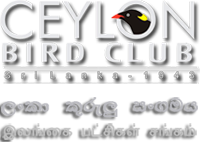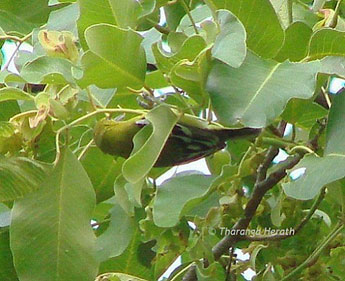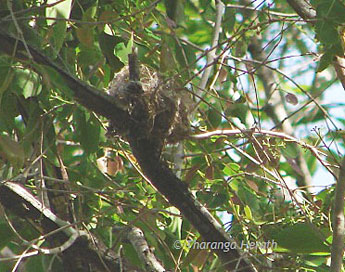


THE MARSHALL’S IORA (AEGITHINA NIGROLUTEA) IN SRI LANKA: A NEW RECORD FROM RUHUNA NATIONAL PARK
Tharanga Herath - CBCN August 2011
 It has long been considered that only a single species of Iora occurs in Sri Lanka. This species is the Common Iora (Aegithina tiphia), a common breeding resident in woodlands throughout the island, usually to about1000m elevation (Harrison, 1999). It occasionally ascends to 1600 metres or more as a visitor (Henry, 1972 & Harrison, 1999). However, a Common Iora specimen collected from Nilgala (Uva Province of Sri Lanka) that was preserved in the collection at Tring was re-identified as a Marshall’s Iora (Aegithina nigrolutea) in 2003 by Wells et al (Wijesinghe, 2007). Before the re-identification of this particular specimen, the Marshall’s Iora would have been overlooked among several plumage variations of the Common Iora (Aegithina tiphia multicolor) believed to occur in Sri Lanka, due to a transitional breeding male plumage variation (Warakagoda, pers. com.) present in the latter species that is very similar to the plumage pattern of the Marshall’s Iora. Those individuals of Ioras were considered usually as males that were assuming breeding plumage. After the new identification of the specimen of Marshall’s Iora, birders looked at these transition males and succeeded in discovering the presently existing populations of Marshall’s Iora. The first observation of a live specimen was made in 2006 at the Yala East National Park (now named Kumana National Park) in the same province and then another population was found at the border of Lunugamwehera National Park located nearly 75km from the first site (Kaluthota, 2007).
It has long been considered that only a single species of Iora occurs in Sri Lanka. This species is the Common Iora (Aegithina tiphia), a common breeding resident in woodlands throughout the island, usually to about1000m elevation (Harrison, 1999). It occasionally ascends to 1600 metres or more as a visitor (Henry, 1972 & Harrison, 1999). However, a Common Iora specimen collected from Nilgala (Uva Province of Sri Lanka) that was preserved in the collection at Tring was re-identified as a Marshall’s Iora (Aegithina nigrolutea) in 2003 by Wells et al (Wijesinghe, 2007). Before the re-identification of this particular specimen, the Marshall’s Iora would have been overlooked among several plumage variations of the Common Iora (Aegithina tiphia multicolor) believed to occur in Sri Lanka, due to a transitional breeding male plumage variation (Warakagoda, pers. com.) present in the latter species that is very similar to the plumage pattern of the Marshall’s Iora. Those individuals of Ioras were considered usually as males that were assuming breeding plumage. After the new identification of the specimen of Marshall’s Iora, birders looked at these transition males and succeeded in discovering the presently existing populations of Marshall’s Iora. The first observation of a live specimen was made in 2006 at the Yala East National Park (now named Kumana National Park) in the same province and then another population was found at the border of Lunugamwehera National Park located nearly 75km from the first site (Kaluthota, 2007).
An observation of a Marshall’s Iora was made in the Ruhunu (Yala) National Park block in 2010 by the present author.
Present observation
While observing birdlife in the shore of ‘Goda kalapuwa’ area close to the main gate of Ruhuna National Park block-1 on the 10th of January 2010, several Ioras were seen moving around in the area. My attention was drawn to a somewhat distinctive bird with more white on its plumage, among them. I followed this particular bird and was able to observe the features of a Marshall’s Iora on it. At close proximity I saw the tail with a clear white tip on the upper surface, which extended along the edge up a certain distance, as well as the yellow collar on its nape, with the aid of my binocular (8X32). The yellow collar merged into the colour of the back, which was yellowish olive green, while the forehead, crown and the wings were black. The rest of the tail was black. The underparts, from the chin to the undertail coverts were bright yellow. There were two broad white wing-bars, which were similar in width. Furthermore, the edges of the tertials were white. These last two features gave this individual a more whitish appearance than the Common Iora. Based on these distinctive field characters I could identify it as a male Marshall’s Iora in breeding plumage. In addition there was a faint yellow tinge to the flight feathers. The bill was grey while the feet were dark grey. Following this bird, I was able to take several photographs with my 5.1 megapixel, 12X optical zoom digital camera. Studying the pictures taken, it was clearly noticed that the bill is finer, sharply pointed and more decurved than that of the Common Iora. There was another individual that came to the same tree but I was unable to watch this bird well since my attention was mainly devoted to the earlier male. There were several other Ioras in nearby trees that I was able to observe and they were Common Ioras, which helped to see and compare the differences.
The site is a dry open area located by a lagoon called ‘Goda Kalapuwa’ before the park entrance. The vegetation consisted of some thorny bushes and larger trees which were mainly ‘Tooth- brush trees’ (=salt bush, Salvadora persica) among them. This could be considered as an open scrubland rather than open woodland. The block 1 of Ruhunu (Yala) National Park is located in the eastern end of the Southern province of Sri Lanka in the Hambantota district. This is a one of the driest parts of the island with semi arid conditions.
Several Ioras were seen coming from the jungle situated on the opposite side of the main road. This area, from whence they appeared was composed of relatively forest type vegetation. When on the lagoon side, all the Ioras were seen only on the Salvadora persica trees. These trees were of a height of about four metres. The observed Marshall’s Iora was in a separate tree of the same species while others were in other trees nearby. It remained for some time on this tree and flew away to another of the same species alone and remained there preening for about 5-6 minutes or longer. The bird was observed for about 12-15 minutes altogether till it moved towards the lagoon. No vocalization was made during the observation period though the calls of Common Ioras were heard from the other areas.
Discussion
Following description of distinctive features is based on Rasmussen. P & Anderton. J (2005), Kazmierczak. K (2000) and Ali. S & Ripley. D, (1987) along with personal observations of Common Iora as well.
 The major distinguishing features used to separate the Marshall’s Iora from the very similar Common Iora at any stage of both sexes are the white tips and edges of tail feathers and tertials trimmed with white of the former. In the Common Iora the tertial edges, when present, are yellowish and narrower than Marshall’s and there is never any white on the tail at any stage. In addition to the above features the breeding male Marshall’s Iora differs from the non- breeding or female Common Iora by having a black crown and a yellow collar. All the above features were noticed in the individual that was seen and according to these it was a breeding male Marshall’s Iora. The male Common Iora in breeding plumage differs by having complete black upper parts and lacking white on both the tail and tertials. Flight feathers in the observed specimen had a yellowish tinge as usually found in the Common Iora. Referring images taken in India I could conclude that this feature along with the above described other features is observed in the specimens from India as well, and these specimens were very similar to the presently described Sri Lankan specimen, in colouration.
The major distinguishing features used to separate the Marshall’s Iora from the very similar Common Iora at any stage of both sexes are the white tips and edges of tail feathers and tertials trimmed with white of the former. In the Common Iora the tertial edges, when present, are yellowish and narrower than Marshall’s and there is never any white on the tail at any stage. In addition to the above features the breeding male Marshall’s Iora differs from the non- breeding or female Common Iora by having a black crown and a yellow collar. All the above features were noticed in the individual that was seen and according to these it was a breeding male Marshall’s Iora. The male Common Iora in breeding plumage differs by having complete black upper parts and lacking white on both the tail and tertials. Flight feathers in the observed specimen had a yellowish tinge as usually found in the Common Iora. Referring images taken in India I could conclude that this feature along with the above described other features is observed in the specimens from India as well, and these specimens were very similar to the presently described Sri Lankan specimen, in colouration.
When comparing with the Illustrations of Rasmussen P & Anderton J, 2005, the individual that was observed had a yellowish white tinge on the flight feathers instead of white as shown in the illustrations and was completely yellow below instead of the greener lower parts shown. When compared with the wing bars of the observed individual, which were very broad, the illustrations showed narrower bars.
In referring the past literature, Ali, S and Ripley, D (1987) describes a specimen found in Sri Lanka (Ceylon) that has showed an intermediate stage between a Marshall’s Iora and the Sri Lankan subspecies of Common Iora (A. t. multicolour). This was two decades ago when the Marshall’s Iora was not recognized in Sri Lanka and this is probably the same specimen that was re-identified to discover the existence of Marshall’s Iora in the island. Even The status of Marshall’s Iora as a separate species had not been settled at that time (Ali. S & Ripley. D 1987). The specimen that was re-identified by Wells in 2003, as a Marshall’s Iora showed a slight tendency towards a Common Iora (A.t multicolor) by having less white on the tail and a darker, greener back than that of a typical Marshall’s (Rasmussen & Anderton, 2005). This specimen is a male that was collected from the Uva province, (South Eastern Sri Lanka) which was previously considered as an aberrant male of Common Iora (Rasmussen & Anderton, 2005). However, the present individual had more white similar to Indian specimens of typical Marshall’s Iora. Considering the above circumstances and since the existence of Marshall’s Iora in Sri Lanka is a new observation, there is more to discover about Sri Lankan populations f this species. At present it is considered as a “Data Deficient” category in the IUCN Red Data List (IUCN & MoENR, 2007). Ornithological knowledge regarding the current status and the taxonomic status of the Marshall’s Iora in Sri Lanka needs to be updated by further studies. Comparing the images taken of the first pair seen in Sri Lanka (Kaluthota, 2007) after the re-identification, this captured pair appeared to be very similar in external appearance Marshall’s Ioras in India.
Acknowledgements
During this observation my wife Mekhala and Mr Majintha Madawala assisted me in the field and I am grateful to them for their help and interest in birds. During referring and finding details of the species my very special gratitude goes to Mr Jagath Gunawardena who kindly allowed me to borrow his valuable reference literature. In addition he read the manuscript and gave some valuable suggestions. Mr Deepal Warakagoda and Mr Lester Perera gave valuable information on the species. I am very thankful to them and to Dr. Pathmanath Samaraweera for expending his valuable time to edit the final document.
References:
Ali, S. & Ripley, S.D (1987) Compact handbook of the Birds of India and Pakistan. 2nd edition, Oxford University Press, Bombay.
Harrison J and Worfolk T (1999); A Field Guide to he Birds of Sri Lanka, Oxford University Press, Oxford.
Henry G.M (1971); A Guide to the Birds of Ceylon 2nd Edition, K.V.G de Silva & sons, Kandy, Sri Lanka
IUCN & MoENR (2007): The 2007 Red List of Threatened Flora and Fauna of Sri Lanka; IUCN Sri Lanka and the Ministry of Environment & Natural Resources, Colombo, Sri Lanka
Kazmierczak K and Van Perlo.B (2000); A Field Guide to the Birds of The Indian Subcontinent, Pica Press, Sussex.
Rasmussen P.C. & Anderton J.C. 2005. Birds of South Asia. The Ripley Guide. Vols. 1 and 2. Smithsonian Institution and Lynx Edicions, Washington, D.C. and Barcelona.
Siriwardhane, M (2007); Notes on the Natural History of Marshall’s Iora. Siyoth- vol- 2 (2) 19-24pp.
Warakagoda D and Hettige U (2008);Birds of Sri Lanka, mp3 sound and image collection on cd-rom-ver-1, Bird Sounds.nl, Netherlands.
Warakagoda D (2008) In: Ceylon Bird Club Notes. 5-6pp
Wijesinghe D.P (2007) comments on birds of South Asia: The Ripley Guide by Pamela C. Rasmussen and John C Anderton (2005). Ceylon Bird Club Notes 83-95 pp.
www.orientalbirdimages.org